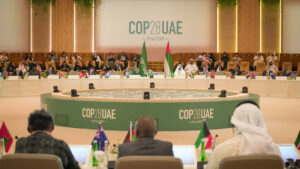
What is the Global Stocktake?
The Global Stocktake document outlines key strategies and commitments aimed at steering the globe towards a sustainable future. We delve into the top highlights and controversies surrounding the GST, shedding light on the potential implications for the fight against climate change.
1. The Fossil Fuel end:
The GST makes strides in signaling the end of the fossil fuel era, albeit with reservations. While there are commendable commitments to replace fossil fuels with clean energy by 2050, the document raises eyebrows with ambiguous references to “transition fuels.” Critics argue that the science is unequivocal – gas is a methane-heavy fossil fuel, not a transitional solution. The call to address a list of fossil fuels rather than a menu adds complexity, leaving questions about absolute consumption unanswered.
2. Energy Transition:
On a positive note, the GST endorses a significant transition towards renewable energy, aiming to triple clean energy and double energy efficiency by 2030. However, the absence of quantification and equity provisions raises concerns, with compromises made to accommodate the preferences of major players like China and India. The emphasis on renewable energy becoming cheaper underscores the global commitment to prioritize sustainable alternatives.
3. 1.5C Reference and Scientific Imperatives:
Para 25-27 of the GST strengthens the commitment to limiting global warming to 1.5 degrees Celsius, drawing on the latest scientific assessments. Requirements for peaking emissions by 2030 and subsequent reductions in 2035 are underscored, maintaining the goal of achieving net-zero carbon by 2050. The science-driven approach provides a solid foundation for climate action, aligning with the urgency emphasized in the recent Intergovernmental Panel on Climate Change (IPCC) reports.
4. NDCs and Timelines:
The GST outlines new Nationally Determined Contributions (NDCs) for 2035, with countries expected to submit more ambitious plans between November 2024 and February 2025. The roadmap to Mission 1.5C aims to enhance international cooperation on the journey to COP30 in Brazil. This timeframe sets the stage for heightened ambition and collaboration to meet critical climate goals.
5. Global Goal on Adaptation:
Despite positive strides, the GST falls short in providing concrete targets and timelines for adaptation efforts. Weak language on financial commitments and ambiguous terms like “transformative adaptation” and “maladaptation avoidance” create uncertainty. The call for a two-year work program on indicators highlights the need for a comprehensive understanding of progress, but the lack of a roadmap to scale finance raises concerns about the implementation of adaptive measures.
As the world navigates the complexities of climate action, the Global Stocktake emerges as a crucial document, signaling both progress and challenges. While commitments to renewable energy and emission reductions are commendable, the ambiguity surrounding transition fuels and adaptation finance demands further scrutiny. As the international community looks towards COP30 in Brazil, the roadmap to Mission 1.5C becomes a beacon of hope, emphasizing the need for global cooperation to address the pressing challenges of climate change.





